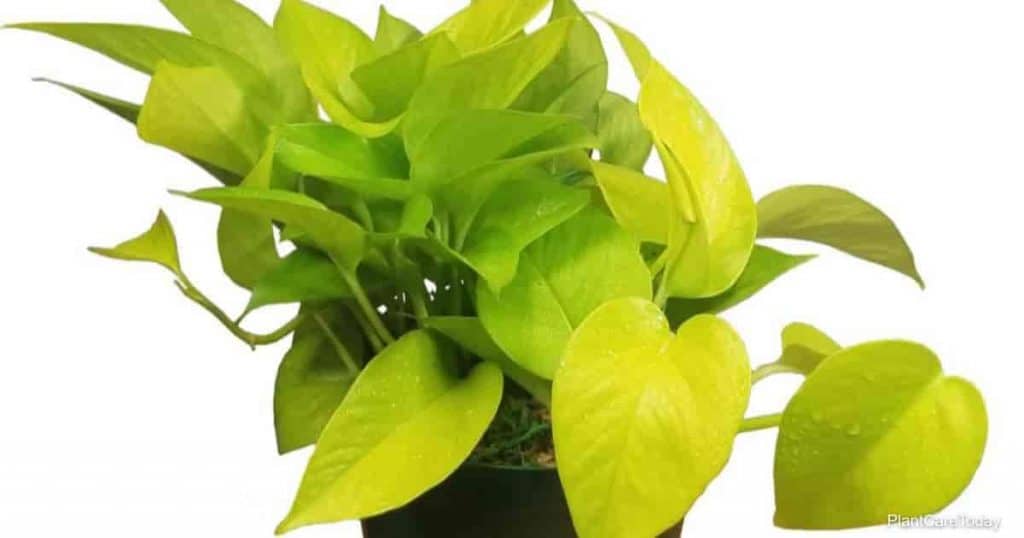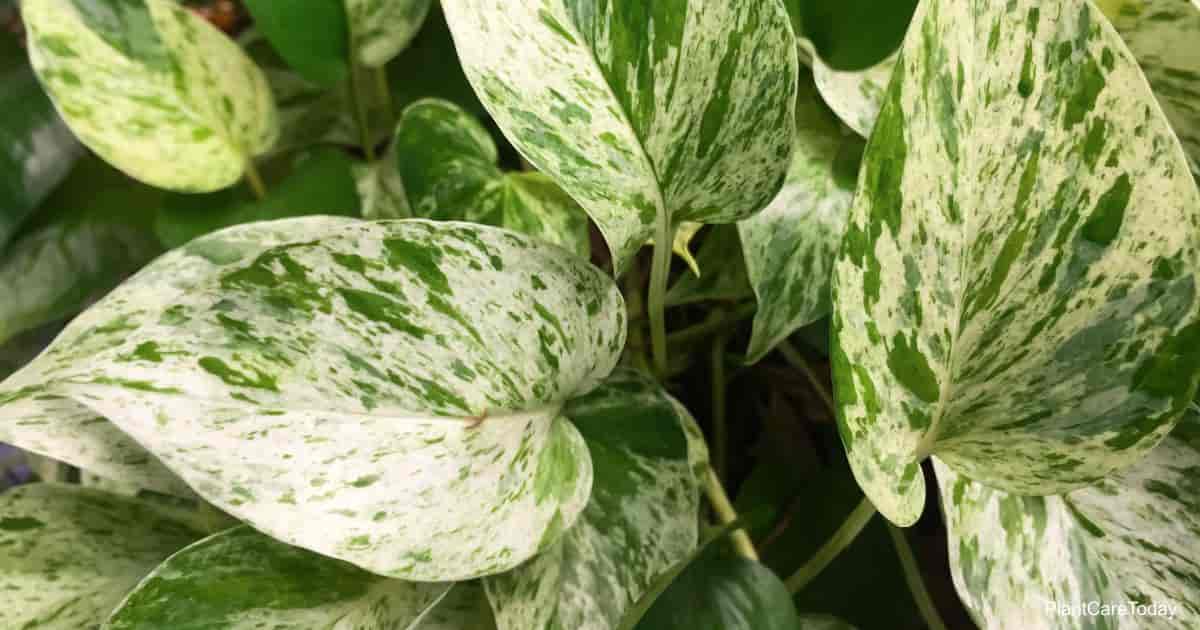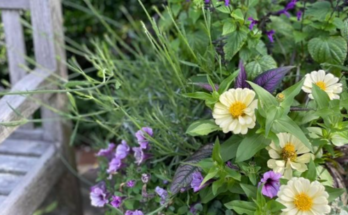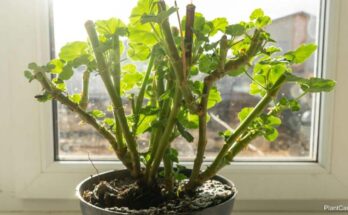Pothos plants are known for their resilience and beauty, making them one of the most popular houseplants. Whether you’re new to plant care or a seasoned green thumb, Pothos is easy to maintain and adds lush greenery to any space.
In this guide, we’ll cover essential Pothos care tips, from watering and lighting to troubleshooting common issues and rejuvenating older plants.
#1 – Understanding Pothos Varieties and Growth Patterns
Pothos, also known as Epipremnum aureum, is available in several varieties, each with unique color patterns. Popular Pothos varieties include Golden Pothos, Marble Queen, and Neon Pothos, all of which have heart-shaped leaves and trailing vines. In the wild, Pothos can grow up to 40 feet, but indoors, Pothos typically reaches 4-6 feet.
Popular Pothos Cultivars include:
- Njoy Pothos: a newer introduction with green and white variegation.
- Marble Queen Pothos: deep green mossy-colored leaves with white streaks.
- Golden Pothos: yellowish green with golden variegated leaves.
- Jade Pothos: Dark green leaves excellent for low-light areas.
- Manjula Pothos: patented variety from the University of Florida, green and white variegation. The leaf edges are slightly wavy.

 Pin
Pin#2 – Lighting Tips for Different Pothos Environments
Pothos plants can adapt to a wide range of light conditions. But thrive best in bright, indirect light. Here’s how to ensure the best light for your plant:
- Low-Light Apartments: Consider using fluorescent grow lights if your space lacks natural light. Position the light about 12-14″ inches away from the plant to avoid overheating the leaves. Rotate the plant every couple of weeks to ensure even light exposure.
- Bright Homes: Homes with large windows and ample light can support Pothos well. However, avoid placing Pothos in direct sunlight as it can scorch the leaves. For south-facing windows, use a sheer curtain to filter the light.
Advanced Tips on Pothos Lighting

 Pin
PinNotice the thick stems and larger leaves with different shapes and forms. | PlantCareToday.com
#3 – Watering Your Pothos: Getting the Balance Right
Watering your Pothos properly is essential for keeping it healthy. These plants prefer to almost dry out between waterings. They can suffer from both underwatering and overwatering.
- Watering Frequency: Water your Pothos when the top inch of soil is dry. Insert your finger into the soil to test for dryness before watering.
- How to Water: Water thoroughly, allowing the excess water to drain out of the bottom of the pot. Be sure to remove any water that collects in the saucer to prevent root rot.
- Tailored Watering Tips:
- Humid Bathrooms: If your Pothos is in a humid area like a bathroom, it may need less frequent watering. Always check the soil moisture before watering.
- Dry Living Rooms: In drier environments, misting the plant occasionally may help but checking soil moisture more frequently is a better option. A pebble tray can help maintain humidity levels around the plant.
The soak-and-dry method of watering is great for Pothos.
#4 – Fertilizing Pothos for Optimal Growth
Pothos plants don’t require a lot of fertilizing, but regular feeding can boost their growth and keep the foliage vibrant. A deeper dive into Pothos Fertilizer
- When to Fertilize: Use a half-strength balanced liquid fertilizer (20-20-20) once a month during the growing season (spring and summer). Avoid fertilizing in the winter when the plant’s growth slows down.
- Signs of Nutrient Deficiency: If your Pothos has pale or yellowing leaves, it might be lacking nutrients. A regular feeding schedule will help restore the plant’s vitality.
If you click this link and make a purchase, we earn a commission at no additional cost to you.
#5 – Repotting and Soil Tips for Healthy Pothos
Pothos are not particularly fussy about their soil, but they do best in a well-draining potting mix. Repotting is essential to ensure they don’t become root-bound.
- Best Soil: Combine a potting soil mix with perlite, and coconut coir works well for Pothos. This combination retains some moisture without becoming waterlogged.
- When to Repot: Repot your Pothos every 2-3 years or when you notice the roots are growing out of the drainage holes. Choose a pot that’s one size larger, and always use fresh soil during repotting.

 Pin
Pin#6 – Grooming and Maintenance: Keeping Your Pothos Looking Its Best
Pothos requires minimal grooming, but regular care will keep it looking lush.
- Pruning: Prune long vines to encourage bushier growth. Snip back stems just above a leaf node using clean scissors. Read our tips on How To Prune Pothos Plants
- Cleaning the Leaves: Dust can collect on Pothos leaves, hindering photosynthesis. Wipe the leaves with a damp cloth regularly to remove dust. Misting the leaves also helps keep them clean and boosts humidity around the plant.

 Pin
Pin#7 – Common Problems and How to Solve Them: Troubleshooting Guide
Even though Pothos are hardy plants, they can still face a few common problems. Here’s a quick guide to keep your plant in top shape:
| Symptom | Likely Cause | Solution |
|---|---|---|
| Leggy, Sparse Growth | Low light | Move to a brighter spot and rotate weekly. |
| Yellow Leaves | Overwatering | Allow the soil to dry out completely before the next watering. |
| Brown Leaf Tips | Underwatering/Dry air | Increase humidity or water more frequently. |
| Slow Growth | Lack of nutrients | Feed with a balanced fertilizer once a month. |
| Wilting Leaves | Over or underwatering | Check soil moisture and adjust watering. |
#8 – Advanced Care for Older Pothos
As your Pothos matures, it may start to grow leggy or show signs of slowed growth. Here’s how to care for older plants:
- Rejuvenating a Leggy Plant: If your Pothos is losing its fullness, prune back the longer vines to encourage bushier growth. You can propagate the cuttings in water and replant them in the same pot to create a fuller plant. Read our article on how to get pothos to grow fuller.
- Dealing with Root-Bound Plants: If the roots are coiling around the base of the pot or growing out of the drainage holes, it’s time to repot your plant into a larger container. Fresh pothos potting soil and more space will encourage new growth.
#9 – Propagating Pothos: Grow More Plants
Pothos are incredibly easy to propagate, allowing you to grow new plants from cuttings. Here’s a quick guide to get started:
- How to Take Cuttings: Cut a 4-6″ inch stem with at least one leaf node (the bump where roots will form). Place the cutting in water or soil.
- Rooting in Water: Place the cutting in a glass of water in a bright spot, but avoid direct sunlight. Roots should form in 2-3 weeks, and you can transfer the cutting to soil once they’re 2-3″ inches long. Read our Tips on Growing Pothos In Water
- Rooting in Soil: Plant the cutting directly in moist soil, and keep the soil slightly damp until roots form.
Details on How To Propagate Pothos
#10 – Seasonal Pothos Care Tips: Adjusting for Winter and Summer
Pothos plants adapt well to indoor environments, but slight adjustments may be necessary based on the season.
- Winter Care: During the winter months, reduce watering frequency as growth slows down. Ensure your Pothos is away from cold drafts and heating vents, as sudden temperature changes can stress the plant.
- Summer Care: In the warmer months, you may need to water more frequently, especially if the plant is in a sunny spot. Keep an eye on soil moisture and adjust as needed.
#11 – Pests and Diseases Affecting Pothos Plants
While Pothos plants are relatively hardy and low-maintenance, they can occasionally suffer from pests and diseases. Here are the most common issues and how to handle them:
Common Pests:
- Mealybugs: These small, cotton-like pests tend to hide in the crevices of the leaves and stems. They feed on the plant’s sap, weakening the plant and causing yellowing leaves. More on controlling Mealybugs on Pothos
- Solution: Use a cotton swab dipped in rubbing alcohol to remove them or apply insecticidal soap to the affected areas. Neem oil can also be used as a natural pest control method.
- Spider Mites: These tiny pests are difficult to see but can cause significant damage, leaving behind fine webbing and small yellow or brown spots on the leaves.
- Solution: Increase the humidity around your Pothos by misting it regularly or placing it on a pebble tray. Treat infestations with neem oil or insecticidal soap.
- Scale Insects: These pests attach themselves to the stems and leaves, appearing as small, immobile bumps. They feed on the plant’s sap and can cause yellowing or drooping leaves.
- Solution: Scrape off scale insects with a soft cloth and treat the plant with horticultural oil or neem oil.

 Pin
PinCommon Diseases:
- Root Rot: One of the most common problems in Pothos plants, usually caused by overwatering or poor drainage. Symptoms include yellowing leaves, mushy stems, and foul-smelling soil.
- Solution: If root rot is detected, repot the plant into fresh, well-draining soil, and trim away any affected roots. Reduce watering and ensure the pot has adequate drainage holes.
- Bacterial Leaf Spot: This disease appears as water-soaked spots on the leaves, which may eventually turn yellow or brown.
- Solution: Remove the affected leaves and avoid misting the plant, as bacteria thrive in moist conditions. Improve air circulation and avoid getting water on the leaves.
- Powdery Mildew: Although rare in indoor Pothos plants, powdery mildew can occur in humid conditions. It appears as a white, powdery substance on the leaves.
- Solution: Reduce humidity around the plant and increase air circulation. Use a fungicide or homemade remedy with a mix of water and baking soda to treat affected areas.
Is Pothos Toxic or Poisonous to People, Kids, Pets?
All parts of all Pothos are quite poisonous to people, pets, and livestock. Pothos contains calcium oxalate, so if it is ingested in large quantities, it can cause a great deal of gastric distress and stomach irritation.
Fortunately, consuming in large quantities is unlikely because contact with the sap can cause a burning sensation in the lips and mouth.
Contact with the sap may also cause contact dermatitis, so be careful when handling your Pothos. Wear gloves and wash up after pruning or repotting the plant.

 Pin
PinPothos is a versatile and resilient houseplant that can thrive in many environments with minimal care. Whether you’re looking to grow a trailing vine or keep a compact tabletop plant, Pothos is perfect for any space.
By following these care tips and troubleshooting common issues, you’ll have a thriving Pothos that will beautify your home for years to come.
Source link





